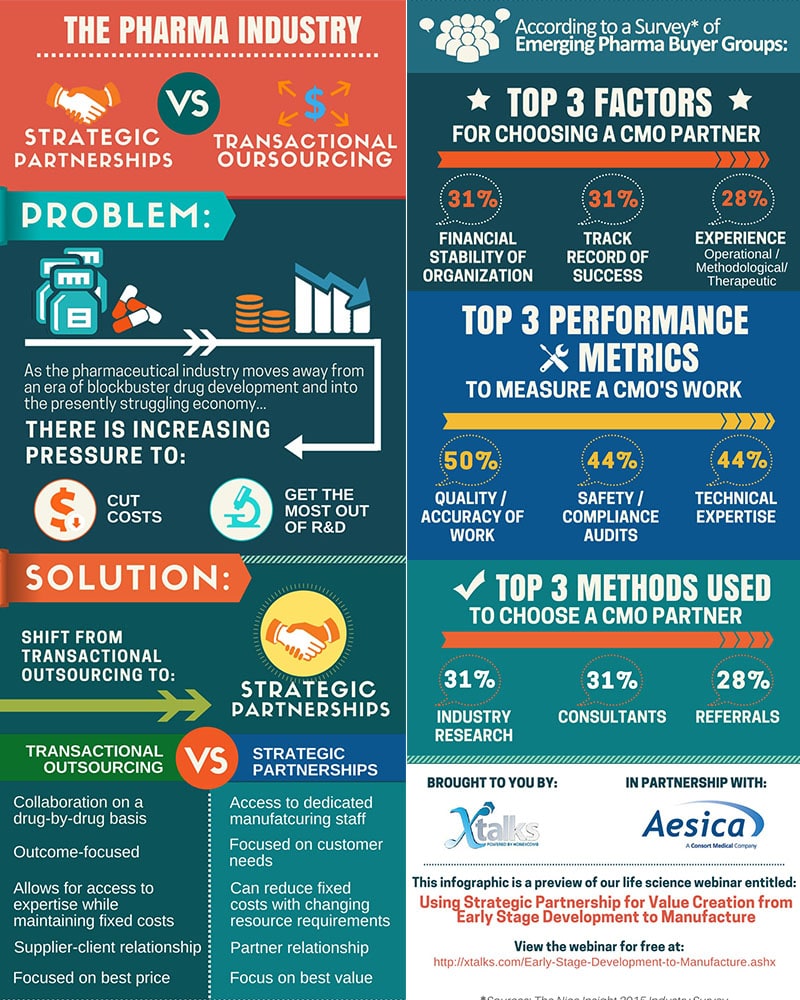
As the pharmaceutical industry moves away from an era of blockbuster drug development and into the presently struggling economy, there is more and more pressure on pharmaceutical companies to cut costs and get the most out of their R&D dollars. In the current age of so-called ‘patent cliffs’ – when one drug going off patent could trigger a dramatic decrease in revenue – pharmaceutical companies are increasingly seeking out strategic partnerships, as opposed to one-off transactional outsourcing of vendors.
But practically, what is the distinction between the two types of collaboration – both of which are aimed towards bringing a drug to market? The differences between transactional outsourcing and strategic partnership formation will be discussed in the context of pharmaceutical company collaborations with contract manufacturing organizations (CMOs).
Strategic partnerships benefit both the pharmaceutical developer and the contract manufacturing organization. By working on a longer-term, complex, symbiotic relationship, contract manufacturing organizations and pharmaceutical companies can both benefit from cost savings, as well as shared resources and mutual growth. Providing each company’s culture fits in well with the others – and a solid line of communication and transparency is established – strategic partnerships can be incredibly successful.
According to The Nice Insight 2015 industry survey, the top three factors that are important to pharmaceutical developers – when choosing a contract manufacturing organization to partner with – were:
- Financial stability of the organization
- Track record/history of success
- Experience (operational/methodological/therapeutic).
Despite the clear benefits of strategic partnerships, a report produced by the CMO Council in 2014, found that over half of all strategic partnerships fail. To understand the benefits – and the common challenges – associated with strategic partnerships, I spoke with Richard Fazackerley, Technical Director, Aesica Pharmaceuticals, who will be speaking in more detail about strategic partnerships in a webinar on October 5th.
What are some common motivators for seeking a strategic partnership, over a transactional relationship?
As the life cycle for drug development can go a very long time – 10 to 15 years, if you’re starting from early research to commercialization – the motivator really is that long-term partnership from the very beginning. This is based on the evolution of not just value creation, but using expertise. Rather than transactional relationships, it is really looking beyond that and acknowledging that this is going to be a long strategic journey and therefore, you need a partner who can add value throughout the different phases. It is a recognition that a short-term transactional relationship doesn’t have as many of the advantages of a longer-term, deeper, strategic relationship could have, in terms of both parties benefitting.
What do you think is the biggest advantage of strategic partnerships?
This biggest advantage is the very nature [of strategic partnerships] – unlike a transactional relationship, a strategic partnership has much more built-in flexibility. It is much more adaptive and it adds a much wider depth of service and learning opportunities to both parties.
What you get with a strategic partnership is something that doesn’t just focus on delivering what’s payed for, you get value in many different ways. It is a two-way process so you not only get value, but you share risk. You can learn, balance capabilities, and find ways to access capabilities that you didn’t have, or maybe didn’t know you needed.
At what stage in a drug’s lifecycle is strategic partnership formation the most beneficial?
There is no single stage; a strategic partnership can be undertaken from the very beginning – in early stages of drug development – irrespective of the size [of the company]. Small- to medium-sized companies can benefit from a number of advantages; they can leverage capabilities and capacities early on.
Strategic partnerships can also give smaller companies the advantage. Rather than having people look at them in terms of value of a single product, a strategic partnership can be a longer-term relationship over many different projects. From early stage development, commercialization, or the launch phase, right through to the end of the life cycle of a product. A strategic partnership – at the highest level – allows you to operate at all stages and adapt throughout the life cycle, but also leverage the capabilities of both parties.
What are some common challenges when building successful strategic partnerships?
I think the key is to recognize that it’s a long-term relationship – by this we’re talking about years or decades, rather than the short-term. The first [challenge] is impatience – you want all the benefits today, rather than build it.
It is a bit like a marriage – it is a commitment over the long-term to build and learn, so you have to put the effort in. You need to recognize there is going to be a lot of time and effort over the life cycle of the product, and the life cycle of the partnership.
What you don’t want to do is get pulled into being impatient and wanting quick results, or focusing on financial reward. Clearly finances are very important, but sometimes you miss the benefit of some of the other forms of value that can be created in a strategic partnership. Transactional relationships focus on financial aspects and delivery, whereas a strategic partnership is much broader and deeper – value in that context can be much different than simply measurable financial aspects.
What are the most important things to consider when deciding on a contract manufacturing organization to partner with?
When deciding on a partner, firstly it is important to have a clear understanding of why you are looking to partner, and why you are looking to select an organization. I think it is a case of trying to identify what would be the best fit for the organization, what would be the right skills, what would be the right capabilities, and what would be the right culture and organizational fit.
Based on my experience over the last 27 years, it is putting the time and effort into finding the right strategic partner and then making sure that both parties have the right resources and the right commitment from the early days. It is a mutually beneficial relationship so you can’t go out there expecting to find a partner who you can just take advantage of.
Again, a bit like a good marriage – it is about finding the right partner and finding the right fit. Do you have shared common values? Do you share the same vision? Do you believe it can work? Then [you need to] work on the relationship, as you move forward.
Realizing the change from a transactional relationship to a strategic partnership is a long process, what is the first and/or most important step in starting the process?
If you want to move away from transactional relationships – where you pay for what you want, and get what you pay for – and you want to move into a more strategic relationship with a partner, you need to have the discussion and recognize that’s what you want from both sides.
You have to realize that it is not going to be simply a transactional relationship, it is going to be something much deeper – there has to be a much different level of transparency, openness, honesty. There needs to be much deeper versions of communication.
Although the transactional partnerships are still there, they are very much subservient to building and maintaining the relationship. In summary, it is a very different relationship from a transactional relationship, which is based on cost and value-perception from the payer. The strategic relationship delivers many more benefits, some of which are easy to define in the early days.
As the relationship develops, many of the benefits become apparent to both parties. Having a deep understanding of each other’s business, allows both parties to identify potential benefits and opportunities.
Is there a ‘magic number’ of vendors that a pharmaceutical company should be striving toward, to make contracting more manageable?
In terms of making contracting more manageable, the Aesica model is outsourcing – we will manage those people on your behalf. It is [about] identifying capabilities and competencies within the company, and identifying [where the company is lacking]. We do manage contract manufacturing organizations on behalf of the client. There are many different ways to look at this – in the strategic partnership, it is identifying the opportunities and the service requirements, and balancing them accordingly.
I recently read a report produced by the CMO Council last year that stated over half of all strategic partnerships fail. Why do you think partnerships fail? What can pharmaceutical companies – in conjunction with contract manufacturing organizations – do in order to ensure success of their collaboration?
The reason for failure is that a strategic partnership – like a good marriage – needs both partners to be involved on an everyday basis. The challenge, is it is very easy to recognize that it requires a lot of time and effort, but the amount of resources and commitment needs to be balanced on both sides.
The commitment of resources and efforts might not necessarily be balanced with reward. The challenge is that the value you are looking to extract might require some time to come to fruition. I think it’s fair to say – and it is not an unusual finding from other party’s observations – that strategic partnerships can fail because either the partners are wrong in the early stages, or the effort put in to make the relationship work, simply doesn’t work.
We’re not talking about a long distance relationship – successfully strategic partnerships need a level of transparency, integration and communication that is quite frankly, quite frightening. You have to expose yourself to the other party, you have to understand their businesses. Maybe you have to share your risks and concerns, and listen [to theirs].
In today’s world, people focus on short term delivery but as you look around, many large successful companies – in some of the economic powerhouses such as Japan and Germany – are based on having long-term, strategic partnerships which have gone on beyond the normal business cycle. That’s why I think many people believe they want a strategic partnership, but they don’t really understand the level of input required to maintain the relationship.
To learn more about how strategic partnerships can help drug makers at all stages of pharmaceutical development, and to get your questions about partnerships answered, register for the upcoming live webinar or recording, Using Strategic Partnership for Value Creation from Early Stage Development to Manufacture, taking place on Monday, October 5, 2015, at 11am EDT (NA) / 4pm BST (UK) / 5pm CEST (EU-Central).
This article was created in collaboration with the sponsoring company and the Xtalks editorial team.












Join or login to leave a comment
JOIN LOGIN